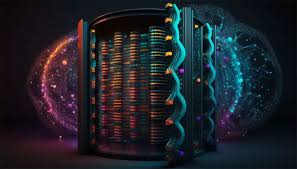
In an age where data storage needs are exploding, traditional hard drives and cloud servers are struggling to keep up. From personal photos to global scientific records, the world generates more information every year than ever before. But what if the solution to the storage crisis isn’t in silicon chips or magnetic disks—but in DNA, the very molecule that encodes life?
1. Why DNA as Data Storage?
DNA is nature’s ultimate storage system. For billions of years, it has held the genetic instructions for every living organism on Earth. Its advantages for digital data are staggering:
- Density: A single gram of DNA can theoretically store up to 215 petabytes of data.
- Durability: Properly stored DNA can last for thousands of years without degradation.
- Universality: Unlike digital formats that become obsolete, DNA is a code that life itself understands.
This means that entire libraries, archives, and even the internet could one day fit into a test tube.
2. How Does DNA Data Storage Work?
The process involves four key steps:
- Encoding: Digital data (1s and 0s) is translated into DNA’s four chemical bases (A, T, C, and G).
- Synthesis: Custom DNA strands are chemically created to match this sequence.
- Storage: The DNA is preserved in tiny containers, often freeze-dried for stability.
- Decoding: Sequencing machines read the DNA and convert it back into digital data.
Though currently expensive, the cost of DNA synthesis and sequencing is dropping rapidly, just as it did for traditional computing decades ago.
3. Who’s Leading the Research?
- Microsoft and the University of Washington have successfully stored and retrieved images, videos, and text from DNA.
- Harvard scientists encoded a full book and even digital images into DNA.
- Startups are now entering the space, aiming to create DNA-based cloud storage services.
These breakthroughs suggest that commercial DNA storage could be available within a couple of decades.
4. The Challenges Ahead
While promising, DNA storage still faces hurdles:
- Cost: Synthesizing and sequencing DNA remains expensive.
- Speed: Writing and reading data is slower compared to traditional drives.
- Error correction: DNA sequences can degrade or mutate, so systems must be designed to catch and fix errors.
Despite these challenges, experts believe that as technology matures, DNA will transition from a novelty experiment to a mainstream storage solution.
5. The Bigger Picture
DNA storage has implications far beyond simply saving files:
- Preserving human knowledge for future civilizations.
- Archiving cultural heritage that could survive wars or natural disasters.
- Interstellar communication, since DNA is a universal code that extraterrestrial life might also understand.
In essence, DNA could become the time capsule of humanity.
Final Thoughts
The future of memory may not be in silicon wafers or magnetic tapes, but in the very molecule of life itself. Storing data in DNA could solve one of the biggest challenges of our digital age, allowing us to preserve information on a scale—and for a duration—that no other technology can match.